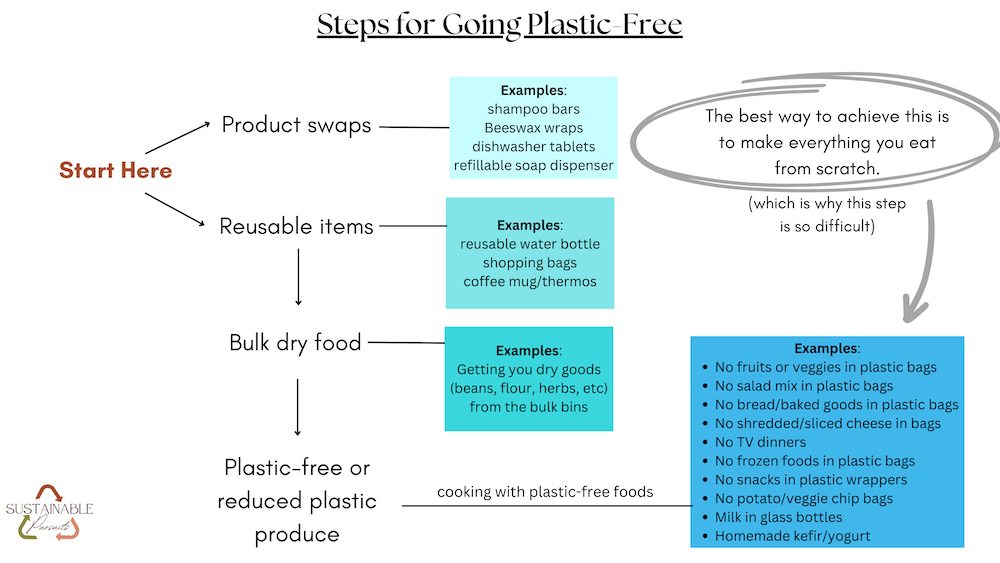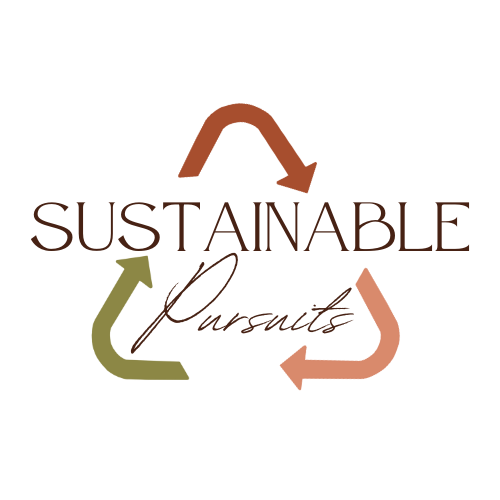Previously, we talked about the beginning steps on how to live plastic-free. For a lot of people who are going plastic-free, these beginning steps tend to be product swaps and reusable items. By that I mean swapping out products for their plastic-free alternatives and using reusable items like water bottles and grocery bags. Both of these require being conscious of your actions and changing your habits. But what do you do if you want to go farther with being plastic-free?
- Where I'm at with plastic-free living
- What I learned about going plastic-free from the monthly challenges
- Why bulk shopping is the next step in going plastic-free
- Why plastic-free food requires more planning
- The next steps for going plastic-free
- Summary of what to focus on now for going plastic-free
- Remember to track your progress
Where I’m at with plastic-free living
The next steps, or next level as I like to call it, to going plastic-free requires even more time commitment than the beginning steps. These next steps are where I’m at currently with my own plastic-free efforts. In 2020, I started swapping out one single-use plastic item with its eco-friendly counterpart once a month. Then last year, 2024, I decided I wanted to push myself to cut out even more plastics. So, I started doing monthly plastic-free challenges as my way to gradually shift my lifestyle.
Note: I cover more about the beginning steps of how to live plastic-free in my previous article. Also, the steps I cover for going plastic-free are based on my own experiences and observations. Please keep in mind these steps are very subjective and not a definite process. So they may, or may not, be applicable to you and your situation.
What I learned about going plastic-free from the monthly challenges
After reflecting on the previous challenges, I realized that there was an additional step I could have focused on. And that I had severely underestimated the effort of going plastic-free with food. I had also overestimated my current cooking skills and habits.
Basically, the main thing I learned from these challenges is that I wasn’t quite ready for going plastic-free with food. It was too much of a change too soon, and I didn’t have certain pieces in place to be successful. Which is why I look at the challenge of plastic-free food as something that requires a definite plan in place. Especially if you aren’t already in the habit of making food from scratch.

Why bulk shopping is the next step in going plastic-free
Again, these steps (swaps > reusables > bulk) are subjective and based on my own situation. So, if this next step isn’t relevant to you, feel free to skip it. I lucked out, and the place I moved to has some amazing bulk food stores. So I’ve been able to refill my pantry items when I run out and need to restock. I’m also able to bring in my own containers which makes this another type of product swap. Yay less waste!
I made bulk shopping it’s own step because this change does require a bit more time on my part. It’s an additional errand every week and I have to remember to bring my own containers. The bulk food commitment is like a cross between the product swaps and reusable items (see my precious article for more detail on these).
Incorporating bulk food shopping into my life
These days I’m getting into a routine where I have a designated bag by the door for the containers I need to refill. When a jar gets low/empty I just put it in the bag. That way I’ve got all my containers ready to go for the next shopping trip. Otherwise, I tend to forget them, or I’m in too much of a hurry to hunt down the jars before I head out.
Note: If you don’t have a bulk food store in your area try to look for food co-ops, they tend to carry bulk foods. Some grocery chain stores like Sprouts also have bulk food bins. If you can’t shop local, I recommend ordering online with Azure Standard* which carries natural/organic foods in bulk. Buying food in bulk bags can still help cut down on plastic waste by reducing the amount of packaging used.
Why plastic-free food requires more planning
So, I’ve got the pantry items and dry foods figured out. It’s working with plastic-free produce that’s proving to be a struggle. I thought I had been realistic with my challenge goals. Except, I overlooked the fact that I don’t have a set schedule. I’m still adjusting to working from home, and I’ve yet to be able to stick to a consistent time table. Which is why this next level of going plastic-free has been so difficult, because it requires a definite time commitment.
Buying plastic-free and reduced plastic produce isn’t the problem (usually)… It’s cooking the foods in a timely manner that’s proving to be the issue. In fact, with each of the previous plastic-free challenges I kept coming across an unexpected setback with my strategies. All of these setbacks provided great insight into what I really needed to address if I wanted to reduce my plastic dependency even further. So I do think I had the right idea with focusing on a monthly challenge, I just need to rethink my overall strategy with meal planning.
The next steps for going plastic-free
Going plastic-free with food means sacrificing convenience, which is very difficult to do. To give up that convenience requires a solid chunk of time to cook, bake, or prep something from scratch. With my schedule problems in mind, my goal is to figure out what plastic-free food strategies are the most impactful for reducing plastic while still being achievable.
That all being said, some of you may already be in the habit of cooking from scratch. If that’s the case, you’re pretty much there. It’s more a question of what foods can you reduce plastic even further. Like buying block cheese instead of the bags of shredded, or maybe adding a vegetarian dish to your menu. I say add a vegetarian meal because that’s one of the few options I was able to find for reducing plastics from meat.
Summary of what to focus on now for going plastic-free
Working on this article and the flowchart has given me more ideas for how to structure the next steps I need for plastic-free foods. I need to give that structure a bit more thought so I will write more about that in another post. So, for now the next steps I recommend for going plastic-free after swaps and reusable items is to focus on your pantry. Dry goods are a great to start shifting to plastic-free foods, especially if there are any stores with bulk bins in your area.
Just a reminder – you don’t have to make this your next step, it’s just the one I recommend. It’s more important to go with whichever step/challenge you feel drawn to and want to achieve.
Remember to track your progress
This is all a great reminder of why it’s important to track your progress when you set a goal. It lets you see how you’re actually doing and provides better clarity on how to move forward. There are free tracking templates on my resource page if you need a tracker for your eco-friendly goals.
(*) indicates an affiliate link where Sustainable Pursuits llc may receive a small compensation for product recommendations. This helps to support Sustainable Pursuits llc and my ability to share these experiences with you!

